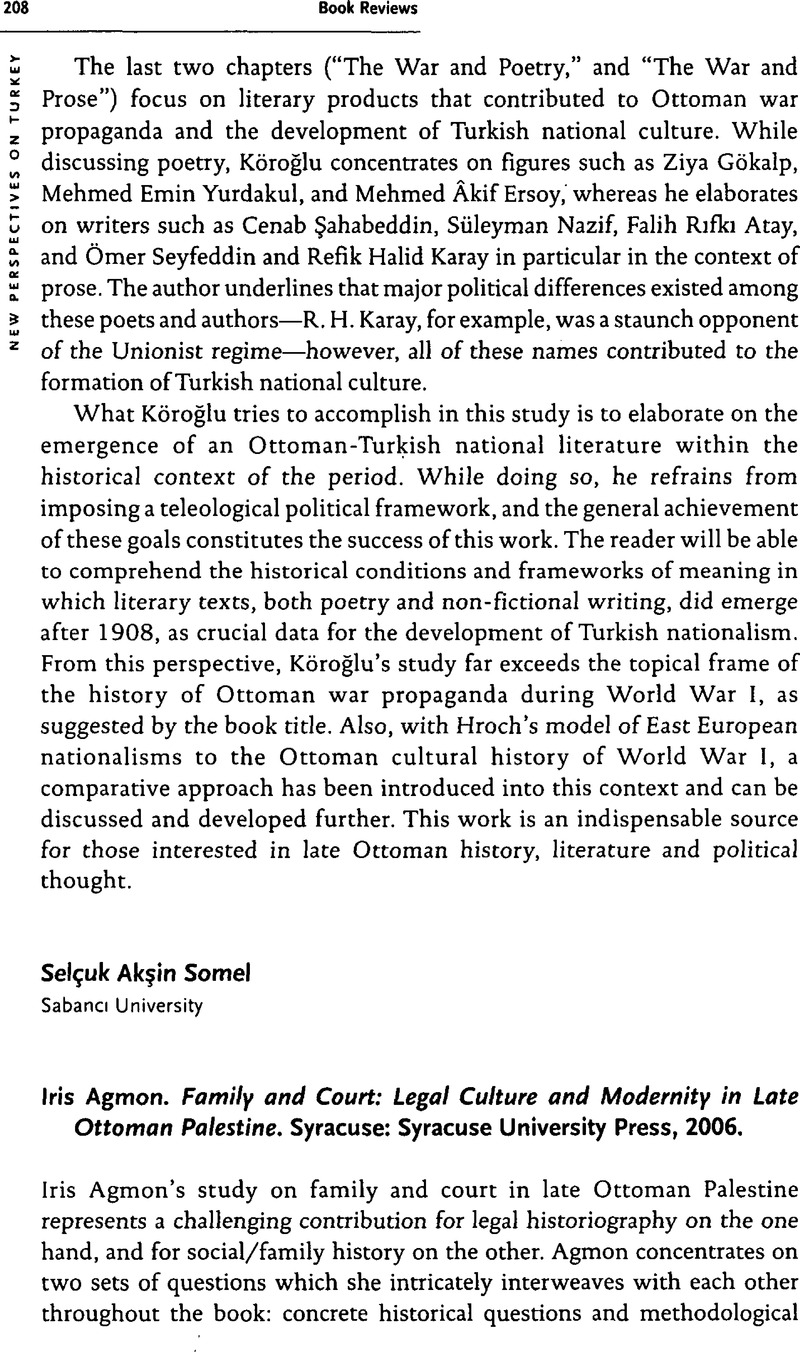Article contents
Iris Agmon. Family and Court: Legal Culture and Modernity in Late Ottoman Palestine. Syracuse: Syracuse University Press, 2006.
Published online by Cambridge University Press: 21 July 2015
Abstract

- Type
- Book Reviews
- Information
- Copyright
- Copyright © New Perspectives on Turkey 2008
References
1 İris, Agmon, Family and Court: Legal Culture and Modernity in Late Ottoman Paletsine, Syracuse: Syracuse University Press, 2006, 48Google Scholar
2 Ibid., 52.
3 Ibid., 50.
4 Ibid., 4.
5 Ibid., 3
6 Ibid.
7 Revel, Jacques, “L’institution et le social”, in Lepetit, Bernard (ed), Les formes de l'expérience, Paris: Albin Michel, 2000Google Scholar.
8 Desan, Susan, The Family on Trial in Revolutionary France, Berkeley: University of California Press, 2004Google Scholar.
9 Sperber, Jonathan, Property and Civil Society in South-Western Germany 1820-1914, Oxford: Oxford University Press, 2005CrossRefGoogle Scholar.
10 Peirce, Leslie, Morality Tales: Law and Gender in the Ottoman Court of Aintab, Berkeley: University of California Press, 2003Google Scholar.
11 Agmon, , Family and Court, 33Google Scholar.
12 Ibid., 51-52.
13 Ibid., 6
14 The reforms affecting the shari'a courts and their judges did not start in the 1850s, as Agmon argues, but in the late 1830s. See Musa, Çadırcı, “Tanzimat'ın İlanı Sıralarında Osmanlı İmparatorluğu'nda Kadılık Kurumu ve 1838 Tarihli Tarik-i İlmiyye'ye Dair Ceza Kanunnamesi”, Dil, Tarih ve Coğrafya Fakültesi Tarih Araştırmaları, 1982, vol. 14, no. 25, pp. 138–161Google Scholar; Akiba, Jun, “Kadılık Teşkilatında Tanzimat'ın Uygulanması: 1840 Tarihli Ta'limname-i Hükkam”, Osmanlı Araştırmaları, 2007, no. 29, pp. 9–40Google Scholar; Ekinci, Ekrem Buğra, Tanzimat ve Sonrası Osmanlı Mahkemeleri, İstanbul: Arı Sanat Yayınları, 2004Google Scholar; İnalcık, Halil, “Application of the Tanzimat and Its Social Effects”, Archivum Ottomanicum, 1973, no. 5, p. 100Google Scholar.
15 For one exception see Bingöl, Sedat, Hırsova Kaza Deâvî Meclisi Tutanakları (Nizamiye Mahkemeleri Tutanaklarından Bir Örnek), Eskişehir: Anadolu Üniversitesi, 2002Google Scholar.
16 Agmon, , Family and Court, 74Google Scholar.
17 Ibid., 126.
18 Ibid., 100-01.
19 Ibid., 167.
20 Ibid., 172.
21 See for example, Mundy, Martha and Smith, Richard S., Governing Property, Making the Modern State: Law Administration and Production in Ottoman Syria, London: I. B. Tauris, 2007Google Scholar.
- 1
- Cited by




